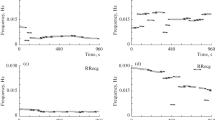Summary
In chronic experiments on 4 dogs a study was made of the dynamics of the ECG T-wave with a rise of the vagus nerve tone; this was done for the purpose of indirect evaluation of the effect produced by the vagus on the metabolic processes in the cardiac muscle. The T-wave dynamics was studied in 2 dogs both in normal conditions and in experimental myocardial infarction. A rise of the vagus center tone was induced by subcutaneous injection of morphine, and a further rise of the tone was attained by intravenous administration of calcium chloride. With an increase of the tone of the vagus center in the intact dogs both the value and the direction of the T-wave changed. In dogs with experimental myocardial infarction T-wave changes resulted from rise of vagus center tone only on the 14th day after the ligation of the descending branch of the lefz coronary artery. On the basis of the data obtained it is suggested that the effect of the vagus nerves on metabolism is not shown until restoration of the functional state of the heart in myocardial infarction, although their inhibitory effect on the heart rate is already restored on the 5th–6th postoperative day.
Similar content being viewed by others
Literature Cited
G. A. Vaksleiger, Physiology and Pathology of the Regulation of Respiration and of the Circulation [in Russian], p. 327, Kuibyshev (1957).
Kh. S. Koshtovants and T. G. Putintseva, Fiziol. zh. SSSR, 5, 414 (1957).
A. F. Samoilov, Russk. vrach., 33, 1089 (1908).
A. I. Smirnov and A. I. Shumilina, Klin. med., 2, 62 (1955).
A. I. Smirnov, S. V. Tolova, and L. S. Ul'yaninskii, Byull. éksper. biol., 12, 33 (1958).
L. I. Fogel'son, Clinical Electrocardiography [in Russian], Moscow (1957).
E. Bittman, Rev. Fiziol. norm. si pat. (1956),3, pp. 61.
H. Bohnenkamp and O. Eichler, Pflüg. Arch. Ges. Physiol. (1926)212, p. 707.
K. Gollwitzer-Meier and C. Kroctz, Klin. Wschr. (1940),19, pp. 580, 616.
H. Gremels, Arch. exp. Path. Pharmak. (1933),169, p. 689.
H. Mellerowicz, Arch. Kreisl.-Forsch. (1956)24, p. 70.
D.R. Morton, K. P. Klassen, J. J. Jacoby et al., Surg. Gynec. Obstet. (1953),96, p. 724.
J. C. Scott and E.A. Reed, Am. J. Physiol. (1951),167, p. 441.
Author information
Authors and Affiliations
Additional information
Translated from Byulleten Éksperimental'noi Biologii i Meditsiny, Vol. 56, No. 11, pp. 52–56, November, 1963.
Rights and permissions
About this article
Cite this article
Smirnov, A.I., Tolova, S.V. & Kovaleva, T.N. Changes in the T wave of the ECG during an increase in tone of the vagus center in normal dogs and in dogs with experimental myocardial infarction. Bull Exp Biol Med 56, 1219–1222 (1963). https://doi.org/10.1007/BF02342823
Received:
Issue Date:
DOI: https://doi.org/10.1007/BF02342823




